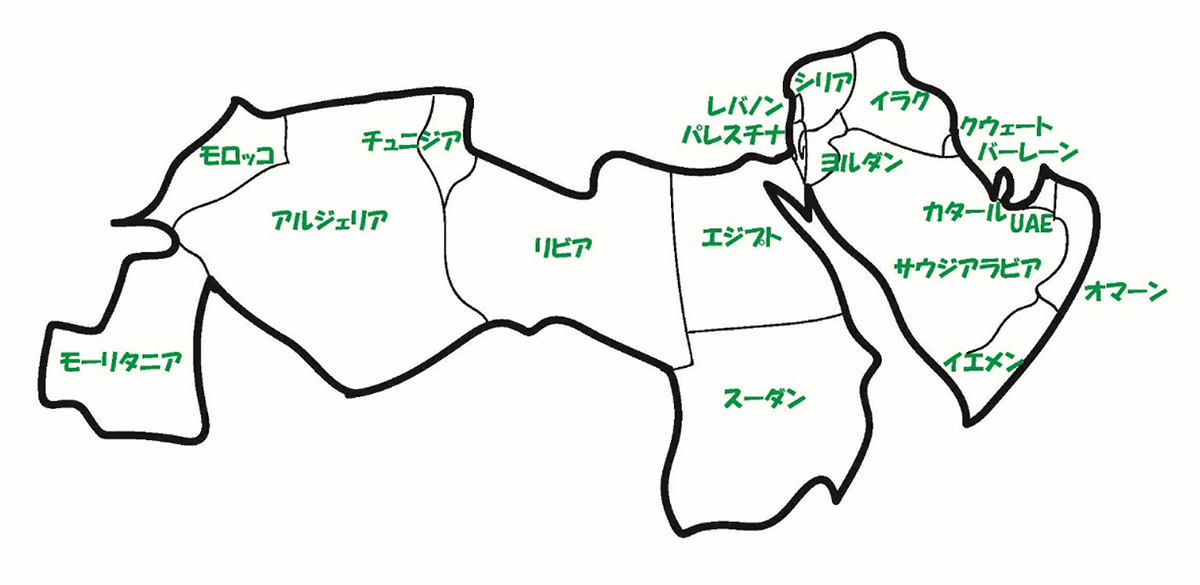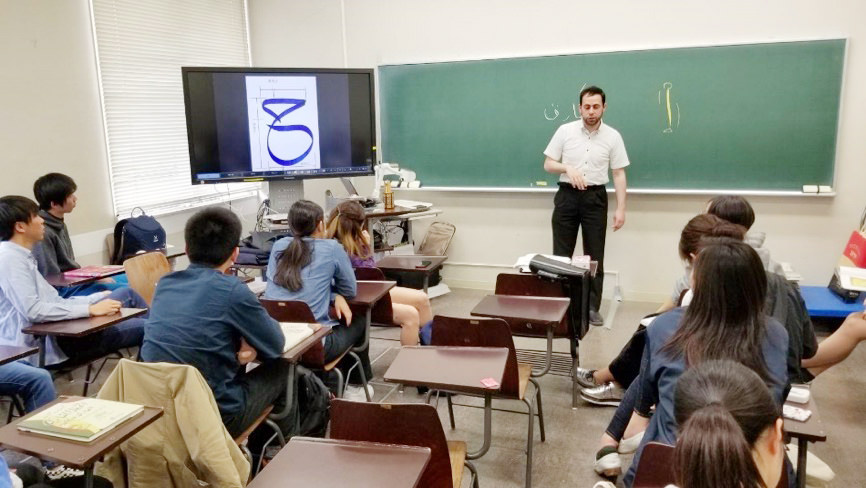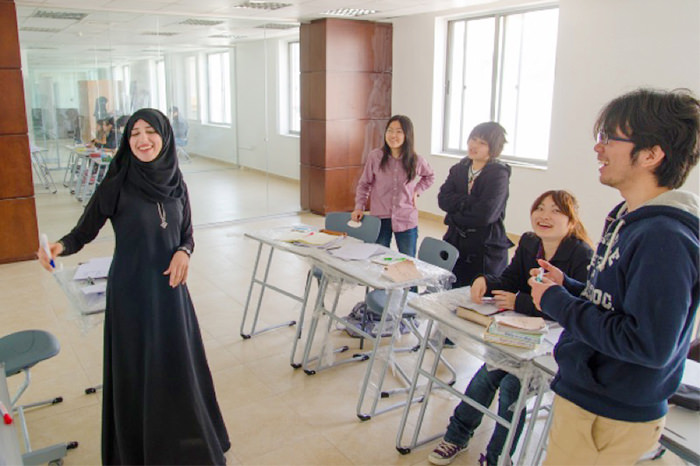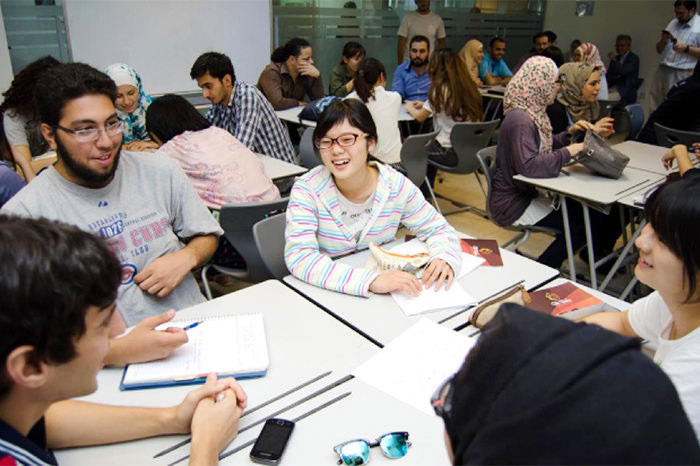
アラビア語Arabic
はじめに
イフタフ・ヤー・スィムスィム(開け、ゴマ)!

アラビア語は西アジアから北アフリカにかけての20を越える国と地域の公用語で、イランやトルコなどの周辺国にもアラビア語の話者は多く暮らしています。さらにはヨーロッパやアメリカなど、世界各地に広がるアラブ系移民たちによっても用いられており、国連の6つの公用語のひとつにも選ばれている国際的な言語です。
また、イスラームの聖典クルアーンはアラビア語でもたらされたことから、世界人口の約4人に1人といわれるイスラーム教徒にとっても、日々の暮らしの中で欠かすことのできない言語になっています。アラビア語で最もよく使われるあいさつに「アッサラーム・アライクム」があります。「あなた方の上に平和がありますように」を意味するこの表現は、世界中のイスラーム教徒のあいだで通じます。
一見複雑そうなアラビア文字ですが、基本的には28個のアルファベットでできており、アラビア語以外にもイランのペルシア語やパキスタンのウルドゥー語など、様々な言語に取り入れられています。習得するのは実はそれほど難しくありません。
かつて栄華を誇ったイスラーム文明圏の知的遺産を今に伝えると同時に、今日の国際語のひとつとして大きな存在感を発揮しているアラビア語を学べば、様々な時代・地域・分野への知の扉が開かれます。まさに「イフタフ・ヤー・スィムスィム(開け、ゴマ)!」。アラビア語は大きな魅力と可能性を秘めた言語なのです。
科目ごとの授業内容

SFCアラビア語の特徴は、日常の場面でのコミュニケーションを想定したオリジナル教材で、読む・書く・聴く・話すの4つの技能をバランスよく身につけることができる点にあります。日本人教員とネイティブ教員が連携しながらきめ細かく指導にあたり、アラブ料理の会やアラビア書道のワークショップなど、授業外でもアラブの生活・文化に触れる機会を提供しています。週4回のインテンシブ・コースを中心に、レベルに応じた海外研修を春・夏ごとに実施しており、インテンシブを終えたらレベルと内容の異なる4つのスキル授業を繰り返し受けることで、アラビア語力をどんどん伸ばし、アラビア語を使った卒業制作につなげることができます。
1. インテンシブ1(春・秋学期ともに開講)
SFCのアラビア語学習の出発点です。週4回の授業でアラビア文字の読み書き、簡単なあいさつや自己紹介の表現を身につけます。
2. インテンシブ2(春・秋学期ともに開講)
インテンシブ1の修了者はインテンシブ2に進めます。同じく週4回の授業で、長い会話スキットを題材に、読み、書き、会話のスキルをバランスよく身につけます。このレベルを修了すると、日常の様々な場面に応じたコミュニケーションができるようになります。
3. ベーシック1(秋学期のみ開講)
インテンシブ1の内容の半分量を、週2回のペースでじっくり学べます。
4. ベーシック2(春学期のみ開講)
ベーシック1の修了者は週2回授業のベーシック2に進めます。ベーシック2に合格すると、インテンシブ2に進むことが可能になります。
5. スキル1~4(春・秋学期ともに開講)
インテンシブ2を修了した学生は、レベルと内容の異なる4つのスキル授業を繰り返し履修することで、アラビア語の力を伸ばしていくことができます。スキル1では文法知識を定着させ、読解と表現の基礎を養います。スキル2はネイティブ教員による会話と作文を中心とした授業、スキル3はスキル1より進んだ内容で総合力を伸ばす授業、スキル4はスキル2より進んだ内容のコミュニケーション中心の授業です。
6. 海外研修(夏休みと春休みに現地で開講)
夏と春に現地でのアラビア語研修(2単位)を実施しています。夏はヨルダンの首都アンマンで、春はモロッコの首都ラバトまたはエジプトの首都カイロで開講され、期間はそれぞれ約2週間です。午前中は初級から上級まで履修者のレベルに応じた少人数クラスでアラビア語を学び、午後には現地の学生や日本語学習者らとの交流活動を通じて学びを深めます。小旅行など、現地の文化や生活に触れる機会も豊富に用意されており、学生たちの知識と視野を広めるまたとない機会となっています。


授業形態図

※インテンシブ1の内容を週2回のペースでじっくり学べるベーシック1は秋学期、ベーシック2は春学期のみ開講です。ベーシック2の合格者はインテンシブ2に進むことが可能になります。
※海外研修とスキルは繰り返し履修することが可能です。
教員スタッフ
- 山本 薫
准教授 - アラブ文学、中東・アラブ圏の文化・社会研究
- アフマド・アルマンスール
訪問講師(招聘) - アラビア語教育、イスラーム学、工学
- ラーウィヤ・ジャームース
非常勤講師 - 非アラビア語母語者へのアラビア語教育、アラブ文学、イスラーム学
- 植村 さおり
非常勤講師 - イスラーム社会研究、イスラーム学、アラビア語教育
- ハディ ハーニ
非常勤講師 - アラブ・イスラーム社会研究、紛争研究
Introduction
Iftah Ya Simsim (Open Sesame)!

Arabic is the official language of more than 20 countries and regions from West Asia to North Africa, and many Arabic speakers also live in the neighboring countries such as Iran and Turkey. It is an international language, having been selected as one of the six official languages of the United Nations, and used by Arab immigrants throughout Europe, the United States, and other parts of the world.
Since the Quran, the sacred scripture of Islam, was written in Arabic, the language has become an indispensable language in the daily lives of Muslims, who make up about 25% of the world's total population. The most common greeting in Arabic is "As-salamu alaykum. " It means "Peace be unto you" which is understood among Muslims around the world.
The Arabic alphabet seems complicated at first glance but is surprisingly simple to learn--it is basically made up of 28 letters and has been incorporated into a variety of languages besides Arabic, including Persian in Iran and Urdu in Pakistan.
Learning Arabic will open doors to knowledge of various periods of time, regions, and fields. It connects us to the past, granting us access to the intellectual legacy of the Islamic Golden Age, while also remaining prevalent as one of today's international languages. It is truly as powerful as the famous incantation "Iftah Ya Simsim (Open Sesame)!" Arabic is a language with great appeal and potential.
Course content

S Arabic language courses at SFC are characterized by their original teaching materials, which are designed for communication in everyday situations, and provide a well-balanced set of four practical Arabic skills (reading, writing, listening, and speaking). Japanese instructors and native Arabic-speaking instructors work together to provide detailed guidance, as well as opportunities to experience Arab life and culture outside of the classroom such as Arab cooking classes and Arabic calligraphy workshops. We offer the Intensive course, which is the core of the Arabic language courses, four times a week, and level-based overseas training every spring and summer. After completing the Intensive course, students can take four Skill courses with different levels and content as many times as they would like to improve their Arabic language ability, and even utilize their Arabic studies in their graduation project.
1. Intensive 1 (offered in both Spring and Fall Semesters)
This is the starting point for learning Arabic at SFC. Students learn how to read and write Arabic characters, as well as greetings and self-introductions in a class that meets four times a week.
2. Intensive 2 (offered in both Spring and Fall Semesters)
Students advance to Intensive 2 after completing Intensive 1. The class meets four times a week and provides students a well-balanced set of reading, writing, and conversation skills through longer conversation skits. Upon completion of this level, students will be able to communicate in a variety of everyday situations.
3. Basic 1 (offered only in the Fall Semester)
Students learn half the content of Intensive 1 twice a week.
4. Basic 2 (offered only in the Spring Semester)
Students who completed Basic 1 may take Basic 2 which is offered twice a week. Those who passed Basic 2 can advance to Intensive 2.
5. Skill 1-4 (offered in both Spring and Fall Semesters)
Students who completed Intensive 2 can further develop their Arabic language abilities by taking four Skill courses with different levels and content as many times as they would like. In Skill 1, students will work on strengthening grammatical knowledge and developing a foundation for reading comprehension and using expressions. Skill 2: the class focuses on conversation and composition taught by native Arabic- speaking instructors; Skill 3: the class fosters comprehensive abilities, going more into depth than Skill 1; Skill 4: the class puts emphasis on communication skills with more challenging material than in Skill 2.
6. Study Abroad Courses (offered in Arabic-speaking countries over summer and spring breaks)
The program takes place during summer and spring breaks (2 credits). The summer program will be held in Amman, the capital of Jordan, and the spring program will be in Rabat, the capital of Morocco, or in Cairo, the capital of Egypt. Each program period is approximately two weeks. In the mornings, students learn Arabic in small classes that match their level--from beginner to advanced--and in the afternoons, they learn by immersing themselves in cultural exchange activities with local students and Japanese language learners. Students also have various opportunities such as excursions to experience local culture and lifestyles, providing them an excellent opportunity to broaden their knowledge and perspectives.


Class System Diagram

*Basic 1 is only offered in the Fall Semester and Basic 2 is only offered in the Spring Semester, allowing students to study the content of Intensive 1 at a slower pace of twice a week. Those who have passed Basic 2 will be able to advance to Intensive 2.
*The Study Abroad and Skill courses may be taken more than once.
Faculty members
- Kaoru Yamamoto
Associate Professor - Arabic literature, cultural and social studies of the Middle East and the Arab world
- Ahmad Almansour
Visiting Lecturer (Full-time) - Arabic language education, Islamic studies, engineering
- Rawya Jamous
Part-time lecturer - Arabic language education to non-native Arabic speakers, Arabic literature, Islamic studies
- Saori Uemura
Part-time lecturer - Islamic social studies, Islamic studies, Arabic language education
- Hani Hadi
Part-time lecturer - Arab and Islamic social studies, conflict studies